|
Civil War Battle of Staunton River Bridge
The Battle of Staunton River Bridge (commonly referred to as the "Battle
of Old Men and Young Boys") was an engagement on June 25, 1864, between Union and Confederate forces during the Siege of Petersburg in the American Civil War. The battle took place around the Staunton River Bridge, over the Staunton
River, in Halifax and Charlotte counties, Virginia. The defense of the Staunton River Bridge ensured the survival of the Richmond
& Danville rail supply line, which was a key part of the chain supplying the besieged Confederate forces in Petersburg. Lee,
however, was forced to abandon Petersburg in April 1865 when his supply lines were finally cut.
| Civil War Virginia Battles Map: Wilson-Kautz Raid |
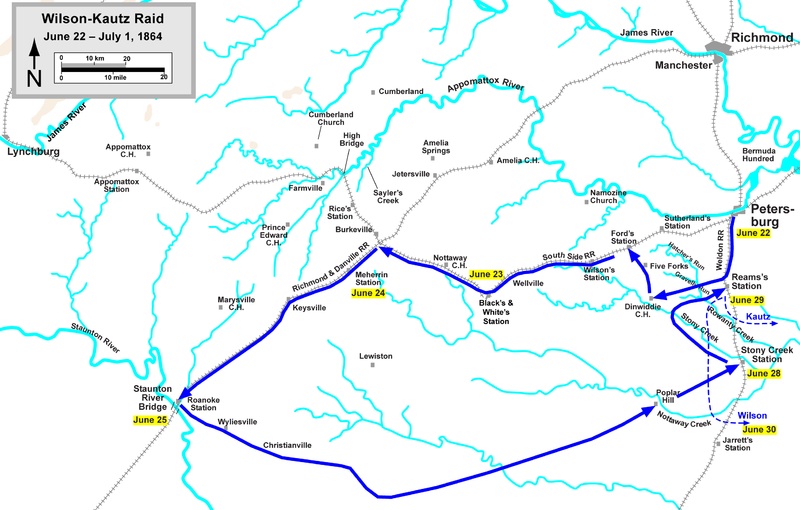
|
| Wilson - Kautz Raid (Battle) Map, June 22 - July 1 |
| 1864 Virginia Civil War Map |
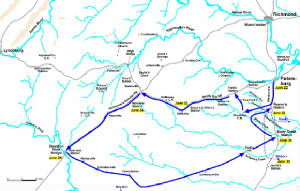
|
| (Click to Enlarge) |
The hot summer day of June 25, 1864, would forever change the lives of 492 old men and young boys from
Southside Virginia. When an urgent plea came from Benjamin Farinholt to come and assist his 296 Confederate reserves in defense
of the Staunton River railroad bridge against an approaching Union cavalry force of over 5000 men, they came from every direction
and all walks of life. This is their story...
In June of 1864, Confederate General Robert
E. Lee and his Army of Northern Virginia were engaged in a desperate defense of the city of Petersburg, Virginia. Victory
for Lee depended upon a steady flow of supplies from the west and south, via the South Side and Richmond & Danville railroads.
Union General Ulysses S. Grant knew that if these supply lines could be destroyed, Lee would have to abandon Petersburg. To
accomplish this, Grant planned a cavalry raid to tear up the tracks of both lines and destroy the Richmond & Danville
railroad bridge over the Staunton River.
The raid began on June 22, and was
led by Brigadier General James H. Wilson and Brigadier General August V. Kautz. They left Petersburg with over 5,000 cavalry
troops and 16 pieces of artillery. As they moved west, the Union raiders were closely pursued by Confederate General W. H.
F. "Rooney" Lee and his cavalry. Although Lee's troopers occasionally skirmished with the invaders, they were unable to stop
their advance. During the first three days of their raid, Wilson's cavalry tore up 60 miles of track and burned two trains
and several railroad stations.
Just south of Roanoke Station (present-day
Randolph) was a long, covered railroad bridge over the Staunton River, Wilson's final objective. The bridge was defended by
a battalion of 296 Confederate reserves under the leadership of Captain Benjamin Farinholt. On June 23rd, at 10 p.m., Captain
Farinholt received word from General Robert E. Lee that a large detachment of enemy cavalry was moving his direction to destroy
the bridge and that he should "make every possible preparation immediately."
| Battle of Staunton River (Bridge) Battlefield Map |
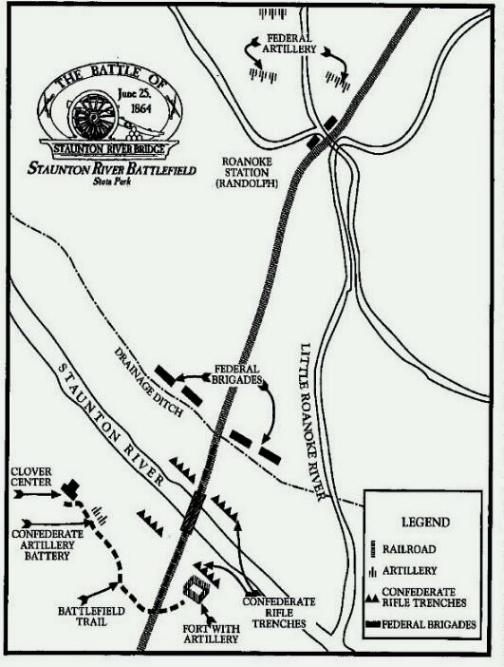
|
| (Courtesy stauntonriverbattlefield.org) |
| Staunton River Bridge |
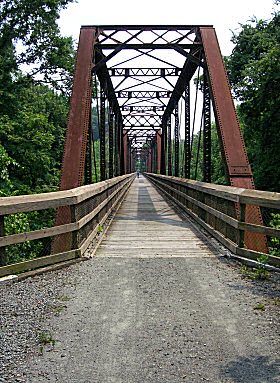
|
| (Historical Marker) |
Captain Benjamin Farinholt: "By the trains at 12 o'clock that night, on the 23rd, I sent off orderlies
with circulars, urging the citizens of Halifax, Charlotte, and Mecklenburg to assemble for the defense of the bridge, and
ordering all local companies to report immediately... On Saturday morning, the 25th, about 10 o'clock I had received, citizens
and soldiers inclusive, 642 re-enforcement. Of these about 150 were regulars, organized from different commands, my whole
command numbered 938 men."
Though his numbers had been bolstered by volunteers,
Farinholt was still badly outnumbered. He had only six pieces of artillery, four in the earthwork fort on the hill just east
of the bridge, and two in a small fortification west of the bridge. Between these artillery positions and the river was a
line of trenches, and across the bridge lay a semicircular line of hastily constructed but well-concealed rifle trenches.
Captain James A. Hoyt with his two companies of regulars were on the east side of the bridge, and Colonel Henry Eaton Coleman's
"Old Men and Young Boys" were on the west side. Scouts and pickets were posted north of the bridge near Roanoke Station.
Captain Farinholt knew that his activities at the bridge were being watched by Union scouts who had arrived ahead
of the main body of troops. To make them think that he was receiving reinforcements, Farinholt ordered an empty train to run
back and forth between Clover Depot and the bridge, giving the appearance that fresh troops were arriving constantly.
As it turned out, the Union scouts were not the only ones fooled.
J.
B. Faulkner: ". . . I happened to be one of Farinholt's scouts that day. We were stationed on the same side of the river with
Wilson's forces on a high hill that overlooked the entire field. When we saw the [train] cars roll in and saw the men apparently
disembarking, we felt sure that our men were being reinforced by every train."
Mulberry
Hill plantation was located on a commanding hill near the battlefield and the grounds of the house served as the Union headquarters
and field hospital during the battle. It is said that Mrs. McPhail, the lady of the house, told the Federals that 10,000 Confederates
lay in wait for them beyond the breastworks and that every train was bringing more.
| 1864 Virginia Civil War Map of Battles |
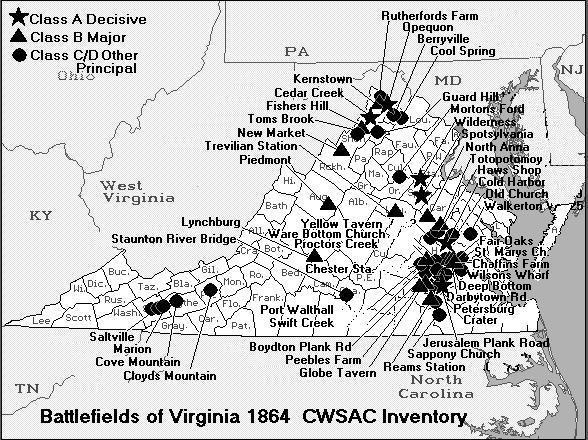
|
| Virginia 1864 Civil War Map of Battlefields |
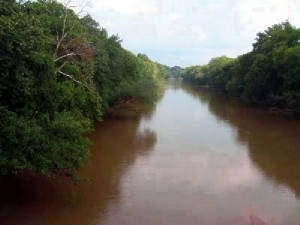
|
| Roanoke River (known locally as Staunton River) |
Captain Benjamin Farinholt: "The enemy [Federals] appeared in my front about 3.45 p.m. . . . I opened
up on them with a 3-inch rifled gun, but the shot, from some inexplicable defect in the gun, fell short of the mark. They
were then within a mile of my main redoubt, and, taking possession of a very commanding hill, immediately opened with rifled
Parrots and 12-pounder Napoleons . . ."
J.T. Easton, 17th Mississippi Regiment:
". . . they opened up with their field guns... The shells striking the thin roof of the bridge made a fearful racket, scaring
some of the small boys into outbursts of weeping."
Having arrived north of
the bridge, General Kautz's cavalry troops were dismounted and formed up to cross the open fields toward the bridge. They
were receiving heavy fire from the Confederate artillery on the other side of the river. Colonel Samuel R Spear's 1st D.C.
and 11th Pa. approached along the east side of the railroad and Colonel Robert M. West's 5th Pa. and 3rd N.Y. along the west
side.
Colonel Robert M. West: "I formed an assaulting party and directed it
up the embankment, in the hope that by a quick move we might obtain possession of the main bridge sufficiently long enough
to fire it. The men tried repeatedly to gain a foothold on the railroad, and to advance along the sides of the embankment,
but could not."
Having finally reached a shallow drainage ditch some 150 yards
north of the bridge, the Union troops organized for what was to be the first of four separate charges, all of them repulsed
by the badly outnumbered Confederate forces. When the Union forces left the drainage ditch for their first assault on the
bridge, they were met by intense fire from Col. Coleman's old men and young boys and the regulars who had been hidden from
view in their shallow trenches around the bridge.
| Staunton River Battlefield Map |
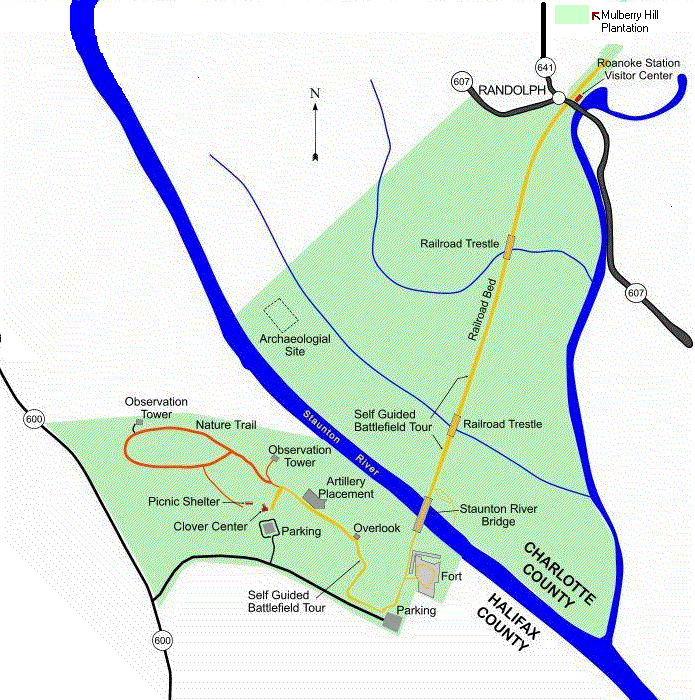
|
| (Courtesy stauntonriverbattlefield.org) |
| Civil War Battle of Staunton River Bridge |
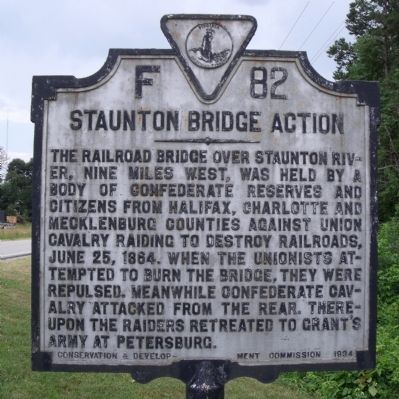
|
| Staunton River Bridge as a Historical Marker |
Captain James A. Hoyt: ". . . the fatal ditch was an obstruction which they never passed again. The second
charge was repulsed with equal gallantry, showing a determined resistance on our side, but it required longer time and heavier
firing to drive them back. Then followed a longer interval between the charges... the third time the effort was made... they
were no nearer the capture of the bridge than when they first came in sight of it.
"The
sun was going behind the hills, but as yet there was no sign that General W. H. F. Lee had reached the enemy's rear. His appearance
on the scene would mean relief for our little band... when the Federals gathered for the fourth charge there were misgivings
as to the result. On they came, however, and they were met with a galling fire of musketry, which grew even more furious as
their lines came nearer It was during this charge that Lee and his division struck the rear-guard of the Federals, and they
were given an opportunity of fighting in opposite directions."
General James H.
Wilson: ". . . the place was found to be impregnable. Finding that the bridge could not be carried without severe loss, if
at all, the enemy being again close upon our rear, the Staunton too deep for fording and unprovided with bridges or ferries,
I determined to push no further south, but to endeavor to reach the army by returning toward Petersburg... The march was therefore
begun about midnight. . . ."
Capt. Benjamin Farinholt: "At daylight, I advanced
my line of skirmishers half a mile, and discovered that the enemy had left quite a number of their dead on the field. In this
advance 8 prisoners were captured ... Of the dead left on the field I buried 42, among them several officers. My loss, 10
killed and 24 wounded."
For the 492 local citizens that made up the "Old Men
and Young Boys" Brigade, the fight was over, and an important supply line had been protected for General Robert E. Lee and
his army in Petersburg. They had proudly answered the call to arms and, in the face of overwhelming odds, distinguished themselves
on the field of battle. Over the years, the stories about their victory on that hot summer afternoon at the bridge have been
retold countless times and have become an important part of the proud heritage of Southside Virginia.
Credits: The preceding are edited excerpts from an audio-map presentation
featured at the visitor center museum and provided courtesy of stauntonriverbattlefield.org
Recommended Reading: The Shenandoah Valley Campaign of 1864 (McFarland
& Company). Description: A significant part of the Civil War was fought in the Shenandoah
Valley of Virginia, especially in 1864. Books and articles have been written about the fighting that took place there, but
they generally cover only a small period of time and focus on a particular battle or campaign. Continued below...
This work covers
the entire year of 1864 so that readers can clearly see how one event led to another in the Shenandoah Valley and turned once-peaceful
garden spots into gory battlefields. It tells the stories of the great leaders, ordinary men, innocent civilians, and armies
large and small taking part in battles at New Market, Chambersburg, Winchester, Fisher’s
Hill and Cedar Creek, but it primarily tells the stories of the soldiers, Union and Confederate,
who were willing to risk their lives for their beliefs. The author has made extensive use of memoirs, letters and reports
written by the soldiers of both sides who fought in the Shenandoah Valley in 1864.
Recommended Reading: General Lee's Army: From Victory to Collapse
(Hardcover). Review: You cannot say that University of North Carolina professor Glatthaar
(Partners in Command) did not do his homework in this massive examination of the Civil War–era lives of the men in Robert
E. Lee's Army of Northern Virginia. Glatthaar spent nearly 20 years examining and ordering primary source material to ferret
out why Lee's men fought, how they lived during the war, how they came close to winning, and why they lost. Glatthaar marshals
convincing evidence to challenge the often-expressed notion that the war in the South was a rich man's war and a poor man's
fight and that support for slavery was concentrated among the Southern upper class. Continued below...
Lee's army
included the rich, poor and middle-class, according to the author, who contends that there was broad support for the war in
all economic strata of Confederate society. He also challenges the myth that because Union forces outnumbered and materially
outmatched the Confederates, the rebel cause was lost, and articulates Lee and his army's acumen and achievements in the face
of this overwhelming opposition. This well-written work provides much food for thought for all Civil War buffs.
Recommended
Reading: Shenandoah Summer: The 1864 Valley Campaign. Description: Jubal A. Early’s disastrous battles in the Shenandoah Valley
ultimately resulted in his ignominious dismissal. But Early’s lesser-known summer campaign of 1864, between his raid
on Washington and Phil Sheridan’s renowned fall campaign, had a significant impact on the political and military landscape
of the time. By focusing on military tactics and battle history in uncovering the facts and events of these little-understood
battles, Scott C. Patchan offers a new perspective on Early’s contributions to the Confederate war effort—and
to Union battle plans and politicking. Patchan details the previously unexplored battles at Rutherford’s Farm and Kernstown
(a pinnacle of Confederate operations in the Shenandoah Valley) and examines the campaign’s
influence on President Lincoln’s reelection efforts. Continued below…
He also provides
insights into the personalities, careers, and roles in Shenandoah of Confederate General John C. Breckinridge, Union general
George Crook, and Union colonel James A. Mulligan, with his “fighting Irish” brigade from Chicago.
Finally, Patchan reconsiders the ever-colorful and controversial Early himself, whose importance in the Confederate military
pantheon this book at last makes clear. About the Author: Scott C. Patchan, a Civil War battlefield guide and historian, is
the author of Forgotten Fury: The Battle of Piedmont, Virginia, and a consultant and contributing writer for Shenandoah, 1862.
Review
"The author's
descriptions of the battles are very detailed, full or regimental level actions, and individual incidents. He bases the accounts
on commendable research in manuscript collections, newspapers, published memoirs and regimental histories, and secondary works.
The words of the participants, quoted often by the author, give the narrative an immediacy. . . . A very creditable account
of a neglected period."-Jeffry D. Wert, Civil War News (Jeffry D. Wert Civil War News 20070914)
"[Shenandoah
Summer] contains excellent diagrams and maps of every battle and is recommended reading for those who have a passion for books
on the Civil War."-Waterline (Waterline 20070831)
"The narrative
is interesting and readable, with chapters of a digestible length covering many of the battles of the campaign."-Curled Up
With a Good Book (Curled Up With a Good Book 20060815)
"Shenandoah
Summer provides readers with detailed combat action, colorful character portrayals, and sound strategic analysis. Patchan''s
book succeeds in reminding readers that there is still plenty to write about when it comes to the American Civil War."-John
Deppen, Blue & Grey Magazine (John Deppen Blue & Grey Magazine 20060508)
"Scott C. Patchan
has solidified his position as the leading authority of the 1864 Shenandoah Valley Campaign with his outstanding campaign
study, Shenandoah Summer. Mr. Patchan not only unearths this vital portion of the campaign, he has brought it back to life
with a crisp and suspenseful narrative. His impeccable scholarship, confident analyses, spellbinding battle scenes, and wonderful
character portraits will captivate even the most demanding readers. Shenandoah Summer is a must read for the Civil War aficionado
as well as for students and scholars of American military history."-Gary Ecelbarger, author of "We Are in for It!": The First
Battle of Kernstown, March 23, 1862 (Gary Ecelbarger 20060903)
"Scott Patchan
has given us a definitive account of the 1864 Valley Campaign. In clear prose and vivid detail, he weaves a spellbinding narrative
that bristles with detail but never loses sight of the big picture. This is a campaign narrative of the first order."-Gordon
C. Rhea, author of The Battle of the Wilderness: May 5-6, 1864 (Gordon C. Rhea )
"[Scott Patchan]
is a `boots-on-the-ground' historian, who works not just in archives but also in the sun and the rain and tall grass. Patchan's
mastery of the topography and the battlefields of the Valley is what sets him apart and, together with his deep research,
gives his analysis of the campaign an unimpeachable authority."-William J. Miller, author of Mapping for Stonewall and Great
Maps of the Civil War (William J. Miller)
Recommended Reading: Ashes of Glory: Richmond
at War. Description:
Drawing on an array of archival sources, Ashes of Glory portrays Richmond's
passion through the voices of soldiers and statesmen, preachers and prostitutes, slaves and slavers. Masterfully orchestrated
and finely rendered, the result is a passionate and compelling work of social history. The siege of Richmond,
Virginia, is unlike anything in the history of America.
For four years the Union soldiers tied an ever-tightening noose around the defiant city. Continued below...
That story--and the way Ernest B. Furgurson tells it--is reason enough to tackle this work. But even more
fascinating is Furgurson's exploration of the minds of the residents who so passionately supported the Confederate cause.
What twist of logic must have inspired a citizenry--many of
whom never owned slaves--to plunge into one of history's bloodiest conflicts? Visit Richmond in its proudest moments, when it envisioned victory; visit Richmond in its darkest times, when it felt flames.
Recommended
Reading: The
Shenandoah Valley Campaign of 1864 (Military Campaigns of the Civil War) (416 pages) (The University of North
Carolina Press). Description: The 1864 Shenandoah Valley Campaign
is generally regarded as one of the most important Civil War campaigns; it lasted more than four arduous months and claimed
more than 25,000 casualties. The massive armies of Generals Philip H. Sheridan and Jubal A. Early had contended for immense
stakes... Beyond the agricultural bounty and the boost in morale to be gained with its numerous battles, events in the Valley
would affect Abraham Lincoln's chances for reelection in November 1864. Continued below...
The eleven
essays in this volume reexamine common assumptions about the campaign, its major figures, and its significance. Taking advantage
of the most recent scholarship and a wide range of primary sources, contributors examine strategy and tactics, the performances
of key commanders on each side, the campaign's political repercussions, and the experiences of civilians caught in the path
of the armies. The authors do not always agree with one another, but, taken together, their essays highlight important connections
between the home front and the battlefield, as well as ways in which military affairs, civilian experiences, and politics
played off one another during the campaign.
Recommended
Reading: Season of Fire: The Confederate
Strike on Washington (Hardcover: 300 pages).
Editorial Review from Booklist: In 1864, Confederate General Jubal Early, outraged by Union depredations
in the Shenandoah Valley by the Federals, launched a bold but futile raid on the outskirts of Washington, D.C. With this event as the central focus of
his narrative, Judge has written a fascinating and riveting account of the men in battle. He masterfully maintains both dramatic
tension and historical accuracy by relating the events through the memoirs of the actual participants. Judge explains the
military maneuvers in language that laypersons can easily grasp, and his portrayals of the key participants breathe life into
the account. Continued below...
Among the more
memorable key-players are Early, the daring general of the valley; Lew Wallace (who would later author “Ben Hur”),
who attempts to block Early's advance; and George Davis, from Vermont, who was awarded the Medal of Honor during this
fiercely contested campaign. This is a fine recounting of a relatively obscure but quite interesting series of events, and
both the general reader and Civil War aficionados will enjoy it. The book also contains sixty-one illustrations.
Try the Search Engine for Related Studies: The Battle of Staunton River Bridge Virginia, Battle
of Old Men and Young Boys, Picture, Photograph, Detailed History, Battlefield Reports and Records of Battle of Staunton River
Bridge Richmond Virginia
|

